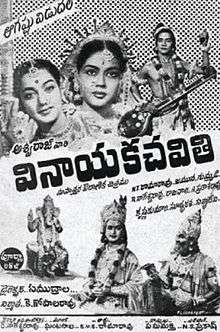Vinayaka Chaviti
| Vinayaka Chaviti | |
|---|---|
 Theatrical release poster | |
| Directed by | Samudrala Raghavacharya |
| Produced by | K. Gopala Rao |
| Written by | Samudrala Raghavacharya (dialogues and lyrics) |
| Starring |
N.T. Rama Rao Krishna Kumari Jamuna Ramanarao Gummadi Venkateswara Rao Rajanala |
| Music by | Ghantasala Venkateswara Rao |
| Cinematography | A. Nageswara Rao |
| Edited by | N. S. Prakash |
Production company |
Revathi Studios |
Release dates | 22 August 1957 |
| Country | India |
| Language | Telugu |
Vinayaka Chaviti (Telugu: వినాయక చవితి) is a 1957 Telugu musical film written and directed by Samudrala Raghavacharya. The story is of Syamantakopakhyanam, annually read during Ganesh Chathurthi festival day celebrations of Lord Vinayaka.
The song Dinakara Subhakara Deva Deenadhara Timira Samhara is a memorable number sung by Ghantasala Venkateswara Rao on Hindu God Surya.
Plot
The plot is narrated by story teller for the benefit of the devotees. It begins with Goddess Parvathi Devi making a mud sculpture of a child in human form and breathing life into it. She makes this child her guard when she goes for bath. She orders him not to let anyone in. When Lord Shiva tries to enter, this child stops him and invites Shiva's anger. Shiva beheads him. Later, knowing from Parvati that the child is his son, he brings the child back to life but with an elephant head (Shiva had once granted this boon to a Rakshasa who became his devotee). They name him Gajanana (In Sanskrit, Gaja = Elephant, Anana = Face) and make him the lord of the Ganas. During a court function, Chandra (Moon god) laughs at him and gets cursed that no one shall see his face on Vinayaka Chavithi. Should anyone happen to see, he/she shall face ignominy brought on by false rumour.
Lord Krishna one day in the house of Rukmini (Krishna Kumari) sees the shadow of Chandra in milk. Satrajit (Gummadi) is staunch devotee of Surya and prays him regularly. His brother is Prasena (Rajanala) and daughter Satyabhama or Satrajiti (Jamuna). He promises to marry his daughter to Satadhanva (Nageswara Rao). Surya impressed by his bhakti gives him the Syamantaka jewel which gives lot of gold daily. Krishna requests Satrajit to give it to him so that he could use it in the service of his people. Satrajit refuses to do so. He gives it to his brother Prasena to protect it. One day Prasena goes hunting into the forest. A Lion kills him and runs off with the jewel. Jambavanta kills the Lion and takes the Syamataka and gives it to his daughter Jambavati. Knowing about the slaying of his brother, Satrajit blames Krishna for killing him. He also prepared for the marriage of his daughter, whereas Satyabhama loves Krishna. Krishna with family goes to the forest and finds out the facts and that the jewel is in the possession of Jambavanta. Krishna fights with this Jambavanta continuously for 28 days and defeats him. Finally, Jambavanta understands that Krishna is none other than the incarnation of His Lord Rama (Jambavanta, at the end of the War against Ravana in the Ramayana, had requested that he be allowed to have a duel with Rama himself. Rama promised him then, that in Rama's next life or avatar, Jambavanta would be granted such an opportunity). He gives away the Jewel along with his daughter to Krishna, who returns to Dwaraka and calls upon Satrajit and presents the Jewel back to him. Guilty of blaming Krishna for no reason, Satrajit gives the Jewel and his daughter Satyabhama to Lord Krishna. Satadhanva knowing about it furiously arrives with forces and kills Satrajit and tries to abduct Satyabhama. Krishna kills him with Sudarshana Chakra. Krishna marries both Satyabhama and Jambavathi.
Cast
| Character | Actor/Actress |
|---|---|
| Lord Krishna | Nandamuri Taraka Rama Rao |
| Rukmini | Krishna Kumari |
| Satyabhama | Jamuna Ramanarao |
| Narada | A. Prakasa Rao |
| Satrajit | Gummadi Venkateswara Rao |
| Sathadhana | Rajanala Nageswara Rao |
| Parvathi Devi | Suryakala |
| Prasena | Rajanala Kaleswara Rao |
| Vasantaka | Balakrishna |
Crew
- Director: Samudrala Raghavacharya
- Dialogues and Lyrics: Samudrala Raghavacharya
- Producer: K. Gopalrao
- Production Company: Aswa Raj Productions
- Art Director :S V S Rama Rao
- Film Editing : N. S. Prakash
- Choreography : Pasumarti Krishna Murthy
- Director of Photography : A. Nageswara Rao
- Original Music: Ghantasala Venkateswara Rao
- Playback singers: M. S. Rama Rao, Ghantasala Venkateswara Rao, P. Susheela
Soundtrack
There are about 24 songs and poems in the film. Music is scored by Ghantasala Venkateswara Rao and Lyrics penned by Samudrala Raghavacharya.[1]
- Aa Nalinakshi Andamula Kandamu Diddedi (Singer: Ghantasala)
- Alinchara Moralinchara Lalinchi Nanu Paripalinchara (Singer: P. Leela
- Arunaya Saranyaya Karunarasa Sindhave (Singer: Ghantasala)
- Chinni Krishnamma Chesina Vintalu (Singer: Ghantasala)
- Dinakara Subhakara Deva Deenadhara Timira Samhara (Singer: Ghantasala Venkateswara Rao; Cast: Gummadi)
- Hare Narayana Tribhuvana Palana Kalapaareena (Singer: Ghantasala)
- Jagadeka Rambhaye Yagugaka Maguvaku Anakuve (Singer: Ghantasala)
- Jaya Gana Nayaka Vinayaka (Singers: Ghantasala, P. Susheela and group)
- Kaliki Ne Krishnudane Palkaveme Bhama Nato (Singers: P. Susheela and A. P. Komala)
- Kannulalo Merise O Nallanaya (Singer: P. Leela)
- Nalugidare Nalugidare Nalugidarare (Singer: P. Susheela group)
- Ninu Nera Nammithira Mohana Krishna Deva Premavatara (Singer: P. Susheela)
- Pratahkale Bhavet Brahma Madhyannetu Maheswara (Singer: Ghantasala)
- Raja Premajoopara Naa Poojala Chekora (Singers: M. S. Rama Rao and P. Leela group)
- Sailasuta Hrudayesa Sambashiva Paramesa (Singer: P. Susheela group)
- Tanuvooge Naa Manasuooge Nunu Tholakari Merupula Talapulao (Singer: P. Leela)
- Thondamuneka Dantamunu Thorapu Bojjayu (Singer: Ghantasala)
- Vatapi Ganapatim Bhaje (Lyrics: Muthuswami Dikshitar; Singer: Ghantasala)
- Vesenu Naa Madi Chindulu Jagamu Chesenu Kallaku Vindulu (Singer: U. Sarojini)
- Yashoda Kishora Prabho Madhava Chanera Vanala (Singer: M. S. Rama Rao and group)